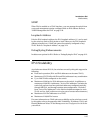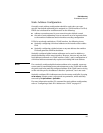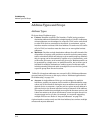
3-6
IPv6 Addressing
IPv6 Addressing Options
Stateful Address Autoconfiguration. This method allows use of a
DHCPv6 server to automatically configure IPv6 addressing on a host in a
manner similar to stateful IP addressing with a DHCPv4 server. For software
release K.13.01, a DHCPv6 server can provide routable IPv6 addressing and
NTP (timep) server addresses. Also, if the host acquires its IPv6 addressing
through stateless or static methods, the DHCPv6 server can still be used to
automatically provide other configuration information to the host. Refer to
page 3-8.
Static Address Configuration. Static configuration is used instead of or in
addition to stateless and stateful autoconfiguration where use of the host MAC
address does not provide the desired level of address control and distribution.
Refer to page 3-9.
Duplicate Address Detection (DAD). IPv6 verifies both the link-local and
the global unicast address(es) on each interface for uniqueness, regardless of
the method used to configure the address. If an address fails this test, it is
identified as a duplicate, and a replacement must be configured using the static
method. (To view address status, use the show ipv6 command.) For more
information on DAD, refer to “Neighbor Discovery (ND)” on page 4-17.
Developing an Addressing Plan. For small, flat networks and any environ-
ment where control of address assignments need not be restricted or tightly
controlled, stateless addressing is adequate for network management and
control. Where systematic and controlled addressing is needed, stateful and
static addressing methods should be used. Where dual-stack operation is used
in a VLAN, incorporating the local IPv4 addressing scheme into the IPv6
addresses you use can help to provide consistency and correspondence
among the IPv6 and IPv4 addresses in use on the VLAN.
Related Information.
■ RFC 4291: “IP Version 6 Addressing Architecture”
■ RFC 2462: “IPv6 Stateless Address Autoconfiguration”
■ RFC 3315: “Dynamic Host Configuration Protocol for IPv6 (DHCPv6)”


















